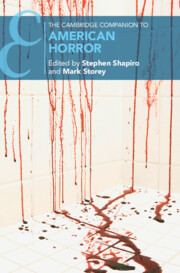Book contents
- The Cambridge Companion to American Horror
- The Cambridge Companion to American Horror
- Copyright page
- Contents
- Acknowledgments
- Contributors
- Introduction
- Part I Histories
- Part II Genres
- 7 Body Horror
- 8 Queer Horror
- 9 Folk Horror
- 10 Occult Horror
- 11 SF and the Weird
- 12 Monsters and Monstrosity
- Index
- Cambridge Companions To …
- References
9 - Folk Horror
from Part II - Genres
Published online by Cambridge University Press: 21 July 2022
- The Cambridge Companion to American Horror
- The Cambridge Companion to American Horror
- Copyright page
- Contents
- Acknowledgments
- Contributors
- Introduction
- Part I Histories
- Part II Genres
- 7 Body Horror
- 8 Queer Horror
- 9 Folk Horror
- 10 Occult Horror
- 11 SF and the Weird
- 12 Monsters and Monstrosity
- Index
- Cambridge Companions To …
- References
Summary
Although initially associated with English forms of horror and Gothic culture, as interest in folk horror has intensified over the past decade it has become apparent that the subgenre’s scope transcends national boundaries. It has also become obvious that there is a distinctive – and evolving – North American folk horror tradition. This chapter has three strands. The first establishes that the powerful North American suspicion of the community in the wilderness owes much to anxieties spawned during the English colonization of North America, as underlined by Robert Eggers’ 2015 film The Witch: A New-England Folk Tale. In the second section the author briefly surveys some of the most prominent post–World War II American folk horror texts. Finally, several recent folk horror texts are discussed in which the recent feminization of American folk horror is placed at the forefront, concluding with a discussion of Ari Aster’s Midsommar (2019).
Keywords
- Type
- Chapter
- Information
- The Cambridge Companion to American Horror , pp. 139 - 153Publisher: Cambridge University PressPrint publication year: 2022
References
Works Cited
- 2
- Cited by



